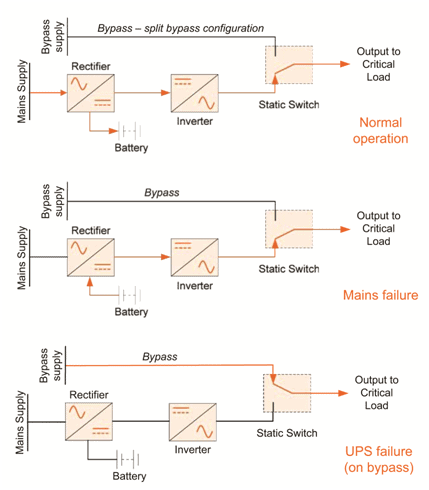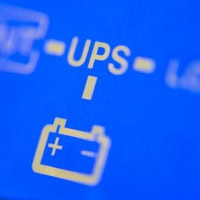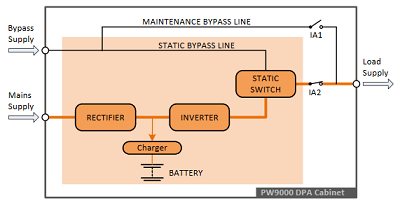Today, UPS systems are typically employed to support data centres, communications hubs and other applications using sensitive ICT equipment. These installations’ continuous availability is usually critical to their owners’ survival, so a clean, uninterrupted power supply becomes a business-critical requirement. Under these circumstances, on line UPSs are understandably the most popular choice. They deliver processed, clean power under all conditions and transfer to battery without power interruption if the mains fails. However there are still many applications with less critical requirements; these can benefit from the lower costs of an off line UPS solution.
With this in mind, Mike Elms, Technial Sales Manager for KOHLER Uninterruptible Power, a KOHLER company, here compares ‘on line’ and ‘off line’ UPS topologies, together with a third variant – line interactive topology – allowing Electrical Review’s readers to make informed power protection choices for themselves or their clients. As rising energy costs sustain the demand for better energy efficiency, the article also reviews Eco mode UPS operation and its contribution to improved PUE.
Applications that use UPSs vary greatly in size as well as nature. Small desk top or instrumentation devices may run from a portable unit with a capacity of up to 250 VA, whereas a large data centre serving a significant enterprise could call for multiple units delivering up to 5MVA or more.
On line UPS topology and advantages
Irrespective of their size or topology, all UPSs depend on a battery, a means of charging it and a method of converting its DC output to AC for the critical load during a mains failure. An on line UPS performs these functions with a series of power blocks between the mains supply and the critical load See Fig 1. The first of these is a rectifier/charger which float charges the battery while the mains is present. It also supplies a stable DC voltage to the second block – an inverter which feeds the critical load. During a mains failure the floating battery seamlessly takes over the task of supplying DC to the inverter, to which it is permanently connected. Therefore, the event remains truly invisible to the critical load unless the battery becomes discharged. This seamless power continuity is a key attraction for critical applications that may not be capable of riding out a switching delay.
Fig 1: On line UPS operation
Another major advantage arises from the on line UPS’s dual conversion topology. The input rectifier removes all the incoming mains spikes, transients and noise by converting it into DC. The inverter then feeds the load with a clean new AC waveform which is tightly regulated by the UPS. The rectifier also provides power factor correction, which reduces high frequency harmonics and the current drawn from the mains. The on line UPS acts as a true power firewall, protecting sensitive instrumentation and ICT equipment from mains-borne problems while improving the load presented to the mains.
Off line topology
By contrast an off line UPS, during normal operation, feeds raw mains to the critical load through a bypass line and static switch – see Fig. 2. The load is therefore exposed to poor voltage regulation and possibly noise and transients from the mains. If the mains transgresses preset limits, the static switch transfers the load to the UPS’s inverter and battery – a changeover break that can last from 2 ms to 10 ms. Many operators of data centres and other sensitive equipment consider off line UPS systems to be unsuitable for their applications because of these power quality and changeover break factors.
Fig 2: Off line UPS topology
Another disadvantage of a basic off line system is that, unlike an on line design, it cannot compensate for mains supply voltage limit transgressions. Instead it must respond immediately by switching between bypass and the inverter for every transgression event. This can happen frequently if the mains supply is unstable or the critical load has a tight voltage tolerance. Apart from subjecting the load to frequent supply interruptions, the battery may have its life reduced or be insufficiently charged as a result.
However applications which can tolerate these disadvantages enjoy two key cost benefits from using off line topology. Firstly, an off line UPS reduces capital costs compared with an on line equivalent through using lower-rated components and dispensing with a power rectifier. Secondly, running costs are lower because the charger and inverter, with their inevitable inefficiencies, are not on line during normal operation.
Line-interactive topology choices
Some UPS manufacturers also offer line-interactive UPS systems. These use off line topology, but address the voltage transgression problems of off line systems mentioned earlier. They do so by providing voltage regulation in the raw mains line which supplies the load during normal operation – see Fig. 3. This voltage regulation, by reducing the number of ‘out of limit’ voltage events reaching the load, lowers the frequency of mains – battery transfers. Apart from subjecting the load to fewer power interruptions, this design offers slightly better running cost efficiency and less battery ‘wear’ than off line systems.
Fig. 3: Line interactive UPS with buck/boost transformer
Line-interactive systems are usually implemented with buck/boost transformers or ferroresonant transformers. Buck/boost transformers will maintain their load voltage over an input voltage range of +20% to -30%, however their switching involves tap changes which impose step voltage changes on the load. Line interactive implementations based on ferroresonant transformers can typically supply a load voltage within 3% of nominal over a raw supply range of +20% to -40%. They also provide power conditioning and protection from disturbances such as electrical line noise. However, their key advantage is that they store enough electrical energy to support most PC loads while the UPS inverter switches on, effectively creating an on line UPS solution.
With today’s rising energy prices, pressure to improve energy efficiency and data centre PUE has renewed interest in eco mode operation of on line UPSs. This mode allows users to route raw mains directly to their critical load during normal operation to save the energy that would otherwise be lost through the UPS’s inefficiencies. However, in exchange for this energy gain of perhaps 3%, the critical load is being exposed to mains disturbances and transfer events, as with an off line UPS. Some users will accept this tradeoff, especially as they can choose to operate the UPS in on line rather than Eco mode during periods of increased utility grid disturbances.
The bigger picture
Overall, operators responsible for data centres and other critical or sensitive loads prefer the processed, ‘no break’ power that only on line UPSs can provide. However to make the most of the topology and its potential for protection, the UPSs should be installed as part of a power scheme that caters for all eventualities. For example, suppose the UPS rectifier and bypass line are fed from a common power source, which at some time suffers a power failure period exceeding the autonomy of the UPS battery. The UPS has no further options, so power to the critical load is lost. In some applications this may be acceptable, because the UPS battery autonomy provides enough time for the critical load to be shut down systematically and safely. In others, this will not be enough; any loss of service is unacceptable.
One solution is to use a configuration known as a split bypass system, in which the bypass line and UPS rectifier are connected to different mains supplies. This means that if the UPS’s supply fails and its battery becomes exhausted, the UPS can switch to the still-healthy bypass line to deliver continued – although unprotected – power to the load.
Another widely used solution is to connect a standby generator as an alternative feed to the UPS. If the UPS detects a mains failure which is more than a transient problem, it can send a startup signal to the generator. This can then run up to speed and stabilise within the UPS battery autonomy, so the load enjoys continued clean power without interruption.
As well as protecting the load from power supply problems, the UPS must also manage problems caused by the load itself. The UPS’s response to an overload may be to transfer it to bypass – but if the bypass supply is not available, this will simply deprive the load of power. A better alternative can be to allow the UPS to supply the overload for a set period; enough for automatic disconnection by a protection fuse or circuit breaker. During this period, the UPS itself can be protected by being operated in current-limited, reduced voltage mode, which is preferable to a total loss of power.
In summary we can say that for critical applications or those involving sensitive equipment, on line UPS topology is the only real solution, due to its delivery of conditioned power and seamless transfer to battery. For less critical applications, off line topology may be suitable, and is attractive due to its reduced capital and operating costs. Line interactive systems offer an improvement on off line topology, with better power conditioning and regulation, and reduced battery wear. Ferroresonant transformer line interactive solutions also offer seamless load transfer. Pressure to reduce PUE has increased interest in Eco mode operation, but this shares most of the characteristics and disadvantages of off line topology. The best possible power quality and availability results come from on line UPS systems designed into an overall power protection strategy.







